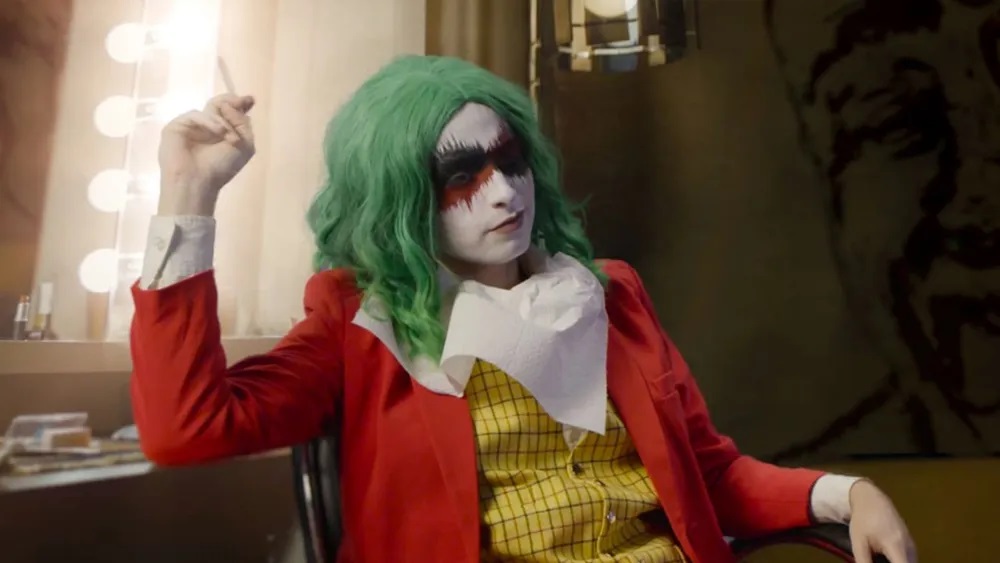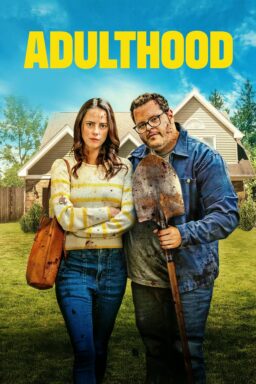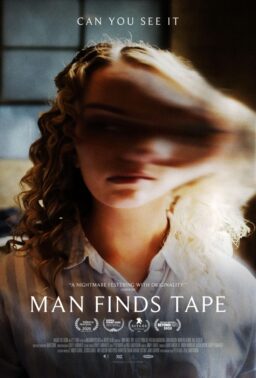Two years after its debut at the Toronto Film Festival, “The People’s Joker” finally opens this Friday. If that sounds like a long time to wait, consider for a second that, for many who attended the movie’s Midnight Madness premiere, it seemed like a miracle that this film would ever get released at all.
Telling the story of an unnamed aspiring comedian (director and co-writer Vera Drew) who lives in a Gotham City in which unsanctioned humor has been outlawed, “The People’s Joker” has been described as a playful plunder of Batman’s iconic universe, specifically riffing on the Oscar-winning blockbuster “Joker.” In the film, Drew emerges as a transgender Joker, dropping in references to everything from The Daily Planet’s Perry White to “Saturday Night Live” kingpin Lorne Michaels, who’s played by Maria Bamford.
Not surprisingly, “a media conglomerate that shall remain nameless,” as Drew described it in a X post, sent her “an angry letter” before the Toronto premiere. (She has gone out of her way to explain that it was not a cease-and-desist letter, as some outlets erroneously reported at the time.) The premiere happened, but subsequent screenings were pulled, putting the film’s future in legal limbo: Surely, Warner Bros. and DC Films weren’t going to allow this borrowing of their intellectual property to see a commercial release.
But “The People’s Joker,” which has been hailed as a landmark in trans visibility, ultimately sidestepped those issues thanks to fair use rules, which allow artists to build on existing copyrights if they add new commentary or recontextualize the original material in a transformative way. (Tellingly, the movie is being advertised as “A Fair Use Film by Vera Drew.”) As a result, “The People’s Joker” will now be released commercially in New York, with a U.S. rollout following from there.
Indie filmmakers tend not to risk angering huge media companies, fearful that they’ll be sued into oblivion. But “The People’s Joker” is only the latest example of a movie that faced legal issues before being released. Below are six of the most famous examples—but be warned, they don’t all have happy endings.
“Titicut Follies” (1967)
Frederick Wiseman is one of the great American directors: At 94, the revered documentarian has produced a half-century’s worth of probing, observational films about institutions and, by extension, society at large. His career began with “Titicut Follies,” a harrowing portrait of Bridgewater State Hospital, a Massachusetts center for the mentally ill. In just 84 minutes, the documentary delivered a scathing portrait of the facility’s terrible living conditions, as the inmates are mocked by the staff, force-fed and otherwise degraded.
Although this was Wiseman’s first film, he knew the importance of getting the proper permissions before he started shooting—including from Elliot Richardson, the then-lieutenant governor of Massachusetts. But Wiseman, who studied law at Yale, was about to run into legal headaches. “When the film was finished I showed it to all of those people and they liked it,” he recalled in 2012. “Then the reviews began to appear and the reviews were critical of the state of Massachusetts for allowing Bridgewater to exist.” Fearful the film would damage them politically, Richardson and others fought to have “Titicut Follies” blocked, arguing that the patients’ privacy rights had been violated, which was nonsense since Wiseman had secured permissions from everyone on camera. Nonetheless, the Massachusetts Supreme Court ruled that the film could only be shown to specific audiences—such as social workers and doctors—effectively banning “Titicut Follies.”
It wasn’t until the early 1990s that “Titicut Follies” was finally allowed public screenings, this stunner’s raw power undiminished over time. Eventually, Bridgewater underwent sweeping reforms, but Wiseman refused to take credit for initiating such changes. “It’s both naive, arrogant, and presumptuous for me or any other filmmaker to say that their film produces social change,” he said. “In a democratic society, people have access to information from so many different sources. You can’t isolate one thing and say that that particular poem or novel or film caused it.”
“Cocksucker Blues” (1972)
The sobering 1970 documentary “Gimme Shelter” captured the hedonism, danger and sex appeal of the Rolling Stones. Two years later, the band would outdo themselves with their next cinematic project—so much so that they fought to keep the completed film out of circulation.
Appropriate to its coarse title, “Cocksucker Blues” is an unvarnished, often unflattering glimpse at the so-called Greatest Rock ‘n’ Roll Band in the World, which was directed by Robert Frank and Daniel Seymour. The film featured rampant drug use, oral sex and lethal amounts of boredom in between shows. In a weird way, “Cocksucker Blues” could be seen as an X-rated precursor to the far-more-benign Radiohead documentary “Meeting People Is Easy,” which chronicled Thom Yorke’s band’s descent into ennui as fame, inane interviews and grueling touring start to grind them down. The big difference is that nobody in Radiohead’s entourage does heroin on camera.
The Stones had commissioned Frank, a photographer who had designed the artwork for their epochal 1972 album “Exile in Main Street,” to make the movie, and Mick Jagger even liked the final product—although he did reportedly say, “It’s a fucking good film, Robert, but if it shows in America we’ll never be allowed in the country again.” Hence the band’s lawsuit to block its release—which led to a curious ruling. “Cocksucker Blues” was only allowed to be shown a few times a year, and Frank had to be present. Not surprisingly, those screenings became sold-out events, even if the film hardly captures the glory of rock ‘n’ roll. As Jim Jarmusch famously put it, “Cocksucker Blues” is “definitely one of the best movies about rock ‘n’ roll I’ve ever seen … It makes you think being a rock ‘n’ roll star is one of the last things you’d ever want to do.”
“Los Angeles Plays Itself” (2003)
One of the defining movies about the City of Angels, “Los Angeles Plays Itself” is a documentary about how the movies have portrayed Los Angeles—and, by extension, how the world sees Los Angeles and Angelenos see themselves. It’s the handiwork of Thom Andersen, a long-time CalArts film professor who had grown tired of L.A. being viewed exclusively through the lens of classic noirs filmed there. “I like film noir,” he said in 2004. “But if that’s the only fiction about Los Angeles that exists, and those are the only movies about Los Angeles that exist, that’s leaving out a lot.” “Los Angeles Plays Itself” was Andersen’s attempt to fill in more of the picture.
Running nearly three hours, this essay film includes clips from hundreds of movies—everything from “Blade Runner” to “Grand Canyon” to “Killer of Sheep” to “The Exiles” to “L.A. Confidential”—and for years, “Los Angeles Plays Itself” only screened at rep theaters, Andersen fearful of seeking distribution. Speaking to the Los Angeles Times, Andersen said he was anxious about being “destroyed by a lawsuit,” adding, “I’m not rich. I’m poor.” In the article, he mentioned that he didn’t want to spend the approximately $3,500 it would have cost him to acquire the insurance premium that would keep license holders of the different clips from suing him. But in 2014, bolstered by fair use rules, Cinema Guild announced it would be releasing the movie on DVD, and it’s currently available for digital rental and streaming, the documentary’s exhilarating commentary and wealth of scenes from all kinds of L.A. movies now available to a much wider audience.
“Room 237” (2012)
Rodney Ascher noticed that, over time, there had become a cadre of online fans of “The Shining” who were espousing complicated theories about what they perceived to be hidden themes buried inside Stanley Kubrick’s 1980 horror classic. “Room 237” was the fascinating result, Ascher allowing each of the theorists to take us down a separate rabbit hole of feverish conjecture, whether it’s advocating that the movie is a critique of the genocide of Native Americans or arguing that Kubrick made the film to secretly acknowledge that he helped fake the NASA moon landing.
When “Room 237” premiered at Sundance, critics rushed to packed screenings, assuming that Ascher would never be able to get permission to release the film—Park City, we presumed, would be the only place we’d ever be able to see it. But thanks to fair use rules, Ascher was permitted to include multiple scenes from “The Shining” (and other Kubrick films) in his documentary. As for Kubrick’s estate, Ascher took pains to stay far removed from anyone involved in the director’s life or in the making of the film.
“We’ve been totally independent from them from the beginning,” Ascher said at the time. “I think this is always about what happens to this film when it hits the minds of the audience, when it leaves the theater, when it leaves the set, when it leaves the laboratory. So we never wanted to talk to anybody directly involved in the making of the film. It would be amazing to talk to some of those folks now and hear what they think about it.”
When “Room 237” hit commercial theaters, it opened with a lengthy disclaimer stating that nothing in the documentary was “approved or endorsed by, or is in any way associated” with the Kubrick estate, Warner Bros. or anybody who had anything to do with the original film. But Leon Vitali, Kubrick’s longtime assistant and advocate, didn’t hide his thoughts about “Room 237,” declaring it “total balderdash” and “pure gibberish.”
“Escape From Tomorrow” (2013)
If you’re going to film at a location, you normally need to get permission from the location’s owners—especially if it’s at a Disney theme park. This did not stop writer-director Randy Moore, who fashioned his directorial debut as a cheeky horror film in which a family goes to Walt Disney World, only for everyday father Jim (Roy Abramsohn) to find out he’s lost his job, a revelation that sends him spiraling. Things only get stranger, though, once Jim learns the horrible truth of what’s going on at the park.
Moore had grown up a Disney kid, but the idea for “Escape From Tomorrow” came to him after he took his Kurkistan-born wife to Disney World for the first time, recognizing how strange the experience was from an outsider’s perspective. “She’s a nurse and goes between floors at hospitals,” he explained. “At one point she turned to me at some princess fair or something and said, ‘This is worse than working the psych world at the hospital.’” And so Moore decided to film in Disney World and Disneyland in secret to convey the parks’ eerie cheeriness.
Part of the movie’s appeal when it debuted at Sundance was that it seemed like Moore was trying to get away with something. (Few companies are as litigious as Disney in protecting its intellectual property, so once its attorneys found out, Moore was surely going to be drowning in lawsuits.) But although the movie’s eventual distributor taunted the Mouse House by fashioning a poster featuring Mickey’s iconic gloved hand dripping with blood, Disney decided the micro-budget movie wasn’t worth the trouble. As The Hollywood Reporter’s Seth Abramovitch put it at the time, “Disney’s silence, rather than legal might, ultimately could hurt ‘Tomorrow’ … Because so much of the film’s fascination hinges on its Disney-defying reputation, a shrug of the studio’s shoulders could deflate that buzz like a three-day-old Mylar balloon.” (By comparison, “The People’s Joker” has no doubt gained notoriety thanks to the public stink Warner Bros. made around that movie’s Toronto premiere.) Disney’s strategy worked: “Escape From Tomorrow” only ended up making about $172,000 during its theatrical release.
“Amazing Grace” (2018)
Aretha Franklin fans thought they’d never see it: the documentary Sydney Pollack filmed in January 1972 as the Queen of Soul recorded a live album in Los Angeles. The resulting record, “Amazing Grace,” remains the best-selling gospel album of all time, but the faithful craved the images that had been captured at the same time. Alas, Pollack’s cameramen had forgotten to use a clapper during the shoot, making it virtually impossible to marry the pictures to the sound. Consequently, the footage sat on a shelf for decades, seemingly destined to be one of the great what-could-have-been films.
But in 2010, a few years after Pollack’s death, momentum began to build to finally assemble the “Amazing Grace” documentary, supervised by producer Alan Elliott, who oversaw the laborious synchronization process. Unfortunately, when Elliott was preparing a 2011 premiere, he was stopped by a lawsuit from an unlikely person: Aretha Franklin. Although the singer had said she “loves” the movie, she claimed he’d used her likeness without her permission, blocking its release.
After decades of waiting for the “Amazing Grace” concert film, it would take another seven years—and Franklin’s death in 2018—for the movie to finally hit theaters. It was only then that Elliott revealed what Franklin’s lawsuit had really been about.
“At a certain point her niece, who is now the executor of the will, came to me and said she had pancreatic cancer,” Elliott recalled. “And that sort of changed the viewpoint on it, to ‘Oh my god, why does she not like the movie’ to ‘Oh my god, we’ve made a eulogy for her’ and so of course she didn’t want the movie out. That became a decision that her family and I made which was not to put the movie out over the last three years because we didn’t want her to have to go through that.”
Now out in the world, “Amazing Grace” is a fitting tribute to an incredible performer. Many of us thought we’d never see that film—but like so many of the examples on this list, it was worth the wait.












